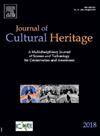A novel traditional technique: Study on microstructure and performance of copper inlay decorative treatment on steel blades
IF 3.3
2区 综合性期刊
0 ARCHAEOLOGY
引用次数: 0
Abstract
In the generational inheritance of traditional crafts, a great deal of important technique information is not directly recorded in literature or archaeological materials. This study analyzes the traditional copper inlay technique used on Longquan Blades, including the inlaying of pure copper and brass on both sides of the steel blade. The main findings of this study are presented as follows based on the use of OM, SEM, EDS, microhardness testing, and electrochemical measurements: (1) Copper is inlaid through a solid-liquid-solid phase transition, successfully bonding the copper decoration with the steel blade matrix, thereby forming a stable inlay interface, demonstrating the feasibility of the liquid copper inlay technique for metal ware decoration. However, the metallurgical bond was not formed at the interface. (2) Hardness test results show that the surface hardness of the steel blade matrix (167.5∼206.3 HV) > copper/steel bonding interface (152.3∼183.9 HV) > copper decoration zone (76.4∼91.9 HV). This hardness gradient is likely to exacerbate stress concentration at the bonding interface. (3) Further electrochemical analysis reveals that the corrosion resistance of the samples follows the order: L01-A < L02-A < L01-C < L02-B < L01-B. This indicates that the composite material interface with inlaid copper has a greater corrosion tendency than single materials. Additionally, the corrosion rate at the bonding interface of brass-inlay samples is lower than that of pure copper-inlay samples. Therefore, this study provides a practical method for reconstructing endangered craftsmanship and technical pathways, underscoring the broader significance of this study.
一种新的传统工艺:钢叶片铜镶嵌装饰处理的组织与性能研究
在传统工艺的代际传承中,大量重要的技术信息并没有直接记录在文献或考古资料中。本研究分析了龙泉刀的传统镶铜工艺,包括纯铜和黄铜在钢刃两侧的镶嵌。基于OM、SEM、EDS、显微硬度测试和电化学测试,本研究的主要发现如下:(1)铜通过固-液-固相变镶嵌,成功地将铜装饰物与钢刀片基体结合,形成稳定的镶嵌界面,证明了液态铜镶嵌技术用于金属器皿装饰物的可行性。但在界面处未形成冶金键。(2)硬度测试结果表明,钢叶片基体表面硬度(167.5 ~ 206.3 HV) >;铜/钢结合界面(152.3 ~ 183.9 HV) >;铜装饰区(76.4 ~ 91.9 HV)。这种硬度梯度可能加剧键合界面处的应力集中。(3)进一步的电化学分析表明,样品的耐蚀性顺序为:L01-A <;L02-A & lt;L01-C & lt;L02-B & lt;L01-B。这表明嵌铜复合材料界面比单一材料具有更大的腐蚀倾向。此外,黄铜镶嵌试样在结合界面处的腐蚀速率低于纯铜镶嵌试样。因此,本研究为重建濒危工艺和技术路径提供了一种实用的方法,凸显了本研究的广泛意义。
本文章由计算机程序翻译,如有差异,请以英文原文为准。
求助全文
约1分钟内获得全文
求助全文
来源期刊

Journal of Cultural Heritage
综合性期刊-材料科学:综合
CiteScore
6.80
自引率
9.70%
发文量
166
审稿时长
52 days
期刊介绍:
The Journal of Cultural Heritage publishes original papers which comprise previously unpublished data and present innovative methods concerning all aspects of science and technology of cultural heritage as well as interpretation and theoretical issues related to preservation.
 求助内容:
求助内容: 应助结果提醒方式:
应助结果提醒方式:


